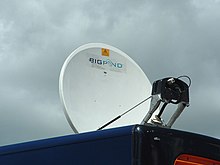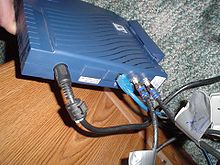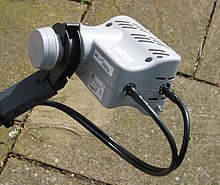Satellite Internet access
This article is missing information about concepts and recent technological developments. (March 2008) |


Satellite Internet services are used in locations where terrestrial Internet access is not available and in locations which move frequently. Internet access via satellite is available worldwide, including vessels at sea and mobile land vehicles.
Mechanics and Limitations of satellite communication
Rain fade
Generally all satellite communications tend to be scattered and absorbed by moisture in the path of signal. This effect is reduced by increasing the size and collection area of the satellite antenna so as to gather and concentrate more of the broadcast signal. Modern consumer-grade dish antennas tend to be fairly small, which makes it easier for the signal to be literally drowned out during moderate rainfall. Very large commercial dishes two to three meters in diameter are less susceptible to rain fade, but can still be affected by the heaviest of downpours.
Latency
Latency is the delay between requesting data and getting a response, or in the case of one-way communication, between the actual moment of broadcast and the time actually received at the destination. Compared to ground-based communication, all satellite communications experience high latency due to the signal having to travel 35,000 km (22,000 miles) out into space to a satellite in geostationary orbit and back to Earth again.
The signal delay can be as much as 500 milliseconds to 900 milliseconds, which makes this service unsuitable for applications requiring real-time user input (such as VoIP, Online Games, Videoconferencing, or other real-time activities. The functionality of live interactive access to a distant computer can also be subject to the problems caused by high latency. These problems are more than tolerable for just basic email access and web browsing and in most cases are barely noticeable.
There is no simple way to get around this problem. The delay is primarily due to the speed of light being 300,000 km/second (186,000 miles per second). Even if all other signaling delays could be eliminated it still takes the electromagnetic wave 233 milliseconds to travel from ground to the satellite and back to the ground, a total of 70,000 km (44,000 miles) to travel from the source to the destination.
Since the satellite is usually being used for two-way communications, the total distance increases to 140,000 km (88,000 miles), which takes a radio wave 466 ms to travel. Factoring in normal delays from other network sources gives a typical connection latency of 500–700 ms. This is far worse latency than even most dial-up modem users' experience, at typically only 150–200 ms total latency.
Line of sight
Typically a completely clear line of sight between the dish and the satellite is required for the system to work. In addition to the signal being susceptible to absorption and scattering by moisture, the signal is similarly impacted by the presence of trees and other vegetation in the path of the signal. As the radio frequency decreases, to below 900 mhz, the penetration through vegetation increases, but most satellite communications operate above 2 gHz making them sensitive to even minor obstructions such as the leaves of a tree. A dish installation in the winter must factor in plant foliage growth that will appear in the spring and summer.
Two-way satellite-only communication

Two-way satellite Internet service sends data from remote sites via satellite to a hub, which then sends the data to the Internet. The satellite dish at each location must be precisely positioned to avoid interference with other satellites. Most providers will oblige the customer to pay for a member of the provider's staff to install the system and correctly align the dish—although the European ASTRA2Connect system encourages user-installation and provides detailed instructions for this. Each location must use power management to adjust the amount of transmit power to compensate for conditions such as rain fade. The oscillators in some radar detectors can also cause interference with these systems.
There are several types of two way satellite Internet services, including time division multiple access (TDMA) and single channel per carrier (SCPC). Two-way systems can be simple VSAT terminals with a 60–100cm dish and output power of only a few watts intended for consumers and small business or larger systems which provide more bandwidth. Such systems are frequently marketed as "satellite broadband" and can cost two to three times as much per month as land-based systems such as ADSL. The modems required for this service are often proprietary, but ones made by companies such as Gilat Satellite Networks are sometimes compatible with several different providers. They are also notoriously expensive, costing in the range of US$600 to $2000.

The two-way "iLNB" used on the ASTRA2Connect terminal dish has a 500mW transmitter and single-polarity receive LNB, both operating in the Ku band. Pricing for Astra2Connect modems range from 299 to 350€. These types of system are generally unsuitable for use on moving vehicles, although some dishes may be fitted to an automatic pan and tilt mechanism to continuously re-align the dish—but these are cumbersome and very expensive. The technology for ASTRA2Connect was delivered by a Belgian company called Newtec.
Bandwidth
Satellite internet providers may have restrictive monthly bandwidth allowances. When a user exceeds this the company may slow down their access, deprioritise their traffic or charge for the excess bandwidth used. For consumer satellite internet, the allowance can range from 500MB to 17GB per month. [1]
Each remote location may also be equipped with a telephone modem; the connections for this are as with a conventional dial-up ISP. Two-way satellite systems may sometimes use the modem channel in both directions for data where latency is more important than bandwidth, reserving the satellite channel for download data where bandwidth is more important than latency, such as for file transfers.
In 2006 the European Commission sponsored the UNIC project which aims at developing an end-to-end scientific test bed for the distribution of new broadband interactive TV-centric services delivered over low-cost two-way satellite to actual end-users in the home. The UNIC architecture employs DVB-S2 standard for downlink and DVB-RCS standard for uplink.
Portable satellite internet
Portable satellite modem
These usually come in the shape of a self-contained flat rectangular box that needs to be pointed in the general direction of the satellite—unlike VSAT the alignment need not be very precise and the modems have built in signal strength meters to help the user align the device properly. The modems have commonly used connectors such as Ethernet or Universal serial bus. Some also have an integrated Bluetooth transceiver and double as a satellite phone. The modems also tend to have their own batteries so they can be connected to a laptop without draining its battery. The most common such system is INMARSAT's BGAN—these terminals are about the size of a briefcase and have near-symmetric connection speeds of around 350–500 kbit/s. Smaller modems exist like those offered by Thuraya but only connect at 144 kbit/s in a limited coverage area.
Using such a modem is extremely expensive—bandwidth costs between $5 and $7 per megabyte. The modems themselves are also expensive, usually costing between $1000 and $4000.
Internet via satellite phone
For many years now satellite phones have been able to connect to the internet. Bandwidth varies from about 2400 bit/s for Iridium network satellites and ACeS based phones to 15 kbit/s upstream and 60 kbit/s downstream for Thuraya handsets. Globalstar also provides internet access at 9600 bit/s—like Iridium and ACeS a dial-up connection is required and is billed per minute, however both Globalstar and Iridium are planning to launch new satellites offering always-on data services at higher speeds. With Thuraya phones the 9600 bit/s dial-up connection is also possible, the 60 kbit/s service is always-on and the user is billed for data transferred (about $5 per megabyte). The phones can be connected to a laptop or other computer using a USB or RS-232 interface. Due to the low bandwidths involved it is extremely slow to browse the web with such a connection, but useful for sending email, ssh and using other low-bandwidth protocols. Since satellite phones tend to have omnidrectional antennae no alignment is required as long as there is a line of sight between the phone and the satellite.
One-way receive, with terrestrial transmit
One-way terrestrial return satellite Internet systems are used with traditional dial-up access to the Internet, with outbound data traveling through a telephone modem, but downloads sent via satellite at a speed near that of broadband Internet access. In the U.S., an FCC license is required for the uplink station only; no license is required for the users.
Another type of 1-way satellite internet system involves the use of General Packet Radio Service (GPRS) for the back-channel.[2] By utilizing a connection that is offered in standard GPRS or EDGE, the upload volume is very low and since this service is not per-time charged, but charged by volume uploaded, users are able to surf and download in broadband speeds. Another view of using GPRS as return would be the mobility when the service is provided by a satellite that transmits in the field of 50 to 53 dBW. Using a 33 cm wide satellite dish, a notebook and a normal GPRS equipped GSM phone, users can get mobile satellite broadband.
System hardware components
The transmitting station (also called "teleport", "head end", "uplink facility", or "hub") has two components:
- Internet connection: The ISP's routers connect to proxy servers which can enforce quality of service (QoS) bandwidth limits and guarantees for user traffic. These are then connected to a DVB encapsulator which is then connected to a DVB-S modem. The radio frequency (RF) signal from the DVB-S modem is connected to an up converter which is connected via feed line to the outdoor unit.
- Satellite uplink: The block upconverter (BUC) and optional low-noise block converter (LNB), which may use a waveguide to connect to the optional orthomode transducer (OMT) which is bolted to the feed horn which is connected by metal supports to the satellite dish and mount.
At the remote location (Earth station) the setup consists of:
- Outdoor unit
- Satellite dish with mount
- Feedhorn
- Universal LNB, for Ku band.
- Feed line
- Indoor unit
- DVB-S Peripheral Component Interconnect (PCI) card internal to a computer
- or, DVB external modem where an 8P8C (RJ-45) Ethernet port or a Universal Serial Bus (USB) port connects the modem to the computer
System software components
Remote sites require a minimum of programming to provide authentication and set proxy server settings. Filtering is usually provided by the DVB card driver.
Often, non-standard IP stacks are used to address the latency and asymmetry problems of the satellite connection. Data sent over the satellite link is generally also encrypted, as otherwise it would be accessible to anyone with a satellite receiver.
Many IP-over-satellite implementations use paired proxy servers at both endpoints so that certain communications between clients and servers [[1]] do not need to accept the latency inherent in a satellite connection. For similar reasons, there exist special Virtual private network (VPN) implementations designed for use over satellite links because standard VPN software cannot handle the long packet travel times.
Upload speeds are limited by the user's dial-up modem, and latency is high, as it is for any satellite based Internet (minimum of 240 ms one-way, resulting in a minimum round-trip time of almost 500ms). Download speeds can be very fast compared to dial-up.
Theory of operation
Remote sites use the proxy server at the earth station (teleport), which is configured to route all outbound traffic to the QoS server, which makes sure no user exceeds their allotted bandwidth or monthly traffic limits. Traffic is then sent to the encapsulator, which puts the IP packets inside of DVB packets. The DVB packets are then sent to the DVB modem and then to the transmitter (BUC).
One-way multicast, receive only
One-way multicast satellite Internet systems are used for Internet Protocol (IP) multicast-based data, audio and video distribution. In the U.S., a Federal Communications Commission (FCC) license is required only for the uplink station and no license is required for users. Note that most Internet protocols will not work correctly over one-way access, since they require a return channel. However, Internet content such as web pages can still be distributed over a one-way system by "pushing" them out to local storage at end user sites, though full interactivity is not possible. This is much like TV or radio content which offers little user interface.
System hardware components
Similar to one-way terrestrial return, satellite Internet access may include interfaces to the public switched telephone network for squawk box applications. An Internet connection is not required, but many applications include an File Transfer Protocol (FTP) server to queue data for broadcast.
System software components
Most one-way multicast applications require custom programming at the remote sites. The software at the remote site must filter, store, present a selection interface to and display the data. The software at the transmitting station must provide access control, priority queuing, sending, and encapsulating of the data.
Reducing satellite latency
Much of the slowdown associated with satellite Internet is that for each request, many roundtrips must be completed before any useful data can be received by the requester.[3] Special IP stacks and proxies can also reduce latency through lessening the number of roundtrips, and/or simplifying and reduce the length of protocol headers. These types of technologies are generally referred to as TCP Acceleration, HTTP pre-fetching and DNS caching.
In space, Internet access is also achieved through satellite-based connection.
See also
- IPSTAR Broadband Satellite
- Back-channel and return channel
- HughesNet (formerly DIRECWAY)
- Ts 2
- IP over DVB
- Satellite dish
- StarBand
- Very small aperture terminal
- WildBlue
- Voice over IP
- Virtual private network
- List of device bandwidths
- Teledesic
- UNIC - UNIversal satellite home Connection
- ASTRA2Connect
References
- ^ http://wildblue.com/legal/WildBlue_Fair_Access_Policy_28-Feb-2008.pdf
- ^ http://www.gilatnetworks.com/data/uploads/CaseStudies/Case%20Study%20Enitel%202007-04%20(GSM%20SkyAbis).pdf
- ^ TCP is bound by the low latency of a three-way handshake. See Transmission Control Protocol.
